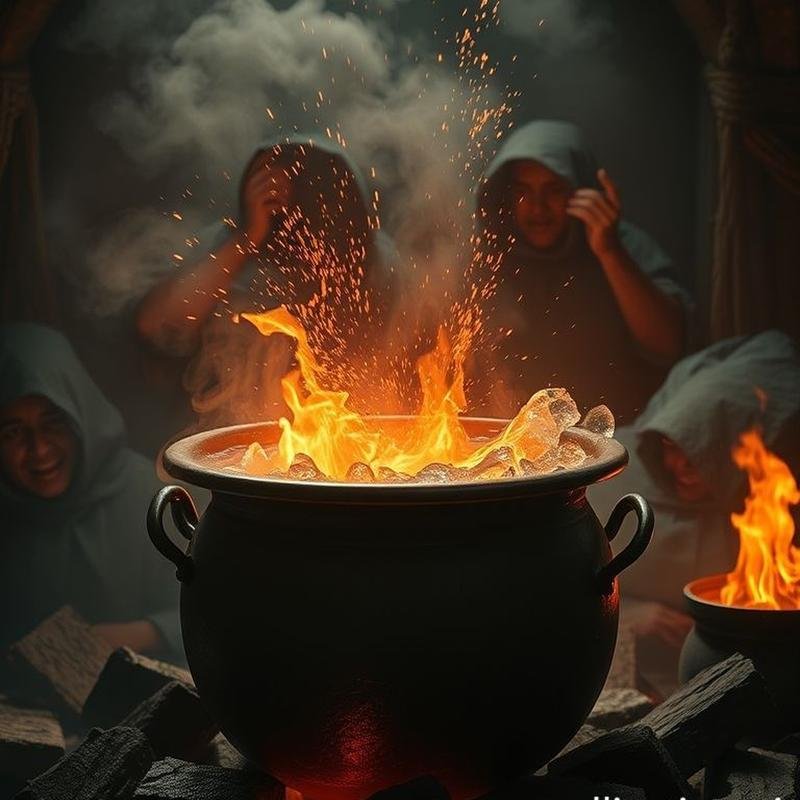The 16th-Century Dancing Plague: Unveiling the Mysteries of Collective Behavior?

Dancing Plague: Unraveling 16th-Century Mass Hysteria
Could the dance of death unlock a map of our hidden minds? This video explores the dancing plague that gripped 16th-century Europe, examining how this peculiar phenomenon can illuminate contemporary collective behaviors, from the rapid dissemination of misinformation to the pervasive influence of digital trends. From the squares of Strasbourg, where scores of dancers succumbed to apparent hysteria, to the social media algorithms that exert remote control over our actions, this historical journey reveals striking parallels in human fears and motivations across centuries. How can an ancient dance explain our propensity to follow the crowd, even towards potentially destructive outcomes? Before we delve into this enigmatic exploration, we invite you to share your initial thoughts: what secrets might the dance of death conceal? To join us in uncovering the full story, please subscribe to the channel.
Historical Accounts: Truth or Exaggeration?
But can we be certain of the veracity of the historical accounts that have reached us? Can we fully trust the records that describe the dancing plague? Our journey of inquiry and analysis begins here, acknowledging that historical narratives are not always definitive truths. The earliest documented instance of the plague dates back to 1518 in Strasbourg, with Frau Troffea’s sudden and uncontrolled dancing. But was she truly the initial catalyst? And was hysteria the sole motivating factor? The physician Paracelsus, who documented the outbreak, proposed three theories: deception, malice, and celestial influence. Did he possess the scientific rigor to ascertain the underlying truth? Or were his interpretations limited by the prevailing understanding of his time? Records indicate that the number of dancers swelled to 400 within a month. But were these figures meticulously tallied, or were they exaggerated to heighten the drama of this unusual event? The city council, after consulting with physicians and astronomers, decided to construct a platform to encourage the dancers, believing that dancing held therapeutic value. Was this a sound medical intervention, or simply a desperate measure to contain widespread chaos?
Ergot Poisoning: A Plausible Explanation?
Ergot poisoning, caused by a fungus that affects rye and induces hallucinations, is another prominent theory. Imagine vast fields of rye, the city’s primary food source, becoming a breeding ground for madness. But has this hypothesis been conclusively proven through scientific investigation? Or does it remain speculative? The ongoing historical debate regarding religious ecstasy versus mass hysteria continues. Which of these explanations more closely aligns with reality? And could they be intertwined?
Modern Research and Mass Hysteria
Modern research casts considerable doubt on the ergot poisoning hypothesis. The characteristic symptoms of ergotism do not fully align with the compulsive dancing exhibited by those afflicted. Vasoconstriction is a more typical manifestation of ergot poisoning, whereas frenzied dancing appears less probable. Therefore, what truly motivated their actions?
The Role of Stress and Social Context
Another hypothesis emerges: mass hysteria, also known as mass psychogenic illness. Envision a society burdened by escalating tensions and oppressive economic conditions, desperately seeking an outlet, any outlet. Intense stress, deeply ingrained cultural beliefs, and established religious practices converge to trigger this collective state of hysteria. We must consider Saint Vitus, the patron saint of dance, whose name became inextricably linked to this strange epidemic. Was faith in him a hidden motive, or merely a catalyst? And could intense social focus on this phenomenon have amplified its severity and propagation? Similar occurrences have been documented in the past, such as the Strasbourg tragedy of 1418. Is this merely a coincidence, or compelling evidence of a recurring pattern in human behavior?
Strasbourg in the 16th Century: A Crucible of Tension
In the heart of 16th-century Strasbourg, religious tensions were not simply theological disputes, but violent power struggles that ravaged a city that had embraced the Protestant Reformation while remaining under the dominion of a staunchly Catholic empire. Then came the years of hardship. Prior to the dancing plague, Strasbourg endured a severe food shortage, soaring prices, and widespread poverty. Imagine the accumulated despair, the hunger gnawing at weakened bodies, and the pervasive fear that gripped afflicted minds. Compounding these hardships were the exorbitant taxes imposed by the Holy Roman Emperor, which burdened the populace and fueled growing discontent. Suffocating economic despair, acute religious tensions, and a burgeoning fear of unseen forces created an atmosphere ripe for superstition and unusual beliefs. Saint Vitus, the patron saint of dance, was not only a revered religious figure, but also a mysterious force to be feared, capable of bestowing blessings or inflicting a deadly curse. And in the fateful summer of 1518, a woman named Frau Troffea began to dance uncontrollably in the streets of the city.
Understanding Mass Hysteria
In this atmosphere of pervasive panic, dancing was not merely a physical act, but a window into the depths of the troubled human psyche. Let us now explore the concept of mass hysteria, a term coined by the French physician Ernest Charles Lasègue in the 19th century to describe instances where physical or psychological symptoms spread among a group of people, without any discernible organic cause. Consider a girls’ boarding school in Tanzania in 1962. Suddenly, an epidemic of hysterical laughter erupted among the students, lasting for months, affecting over a thousand girls, and ultimately leading to the school’s closure. This was not simply casual laughter, but a genuine episode of mass hysteria, spreading without any apparent medical explanation. And in 1965, in Blackburn, England, more than 300 women experienced dizziness and severe nausea after hearing a strange noise. A wave of collective panic swept through the area, before it was later determined that the entire event was an illusion fueled by mass hysteria. But what is the underlying mechanism? How can profound fear and anxiety manifest as tangible physical symptoms? A study published in the journal Psychological Medicine in 2000 sheds light on this phenomenon, confirming that mass hysteria often arises in environments characterized by intense stress, anxiety, and uncertainty. The French sociologist Émile Durkheim further illuminates this concept with the notion of collective effervescence, explaining how shared emotions can foster a strong sense of unity and profoundly influence individual behavior. There is also the phenomenon of social contagion, the natural inclination of individuals to imitate the behaviors of others, particularly in ambiguous and uncertain situations.
Echoes of the Past: Modern Manifestations of Mass Hysteria
So, was Frau Troffea, with her initial episode of uncontrolled dancing in the streets of Strasbourg, simply the spark that ignited a widespread conflagration of fear? Perhaps she was. History often repeats itself, albeit in different forms. Consider Morgellons syndrome, a perplexing medical condition in which individuals experience skin lesions and unusual sensations, while others question its organic basis. Is this not simply a modern echo of ancient mass hysteria? Or consider the laughter epidemic that swept through Tanzania, where uncontrollable laughter spread, leading to school closures, without any clear medical explanation. Is this so different from the tulip mania in Holland, where mass hysteria led to a devastating economic collapse? The Martian panic of 1938, the incidents involving menacing clowns in 2016, and even Gulf War syndrome and the “don’t touch me” effect in a Malaysian factory, all provide compelling evidence of the power of the collective mind and its remarkable ability to shape our reality, even when it defies rational explanation. These are not isolated incidents, but a stark reminder that fear and anxiety can spread like a virus, and that the human mind, in moments of vulnerability, becomes fertile ground for infection.
Social Contagion: A Modern Pandemic of the Mind
Social contagion… more than just a sneeze in a crowded room. It is the transmission of emotions, ideas, and behaviors, much like a virus, but one that infects minds rather than bodies. Imagine an idea, a mere spark, moving from one mind to another, igniting a widespread wave of shared actions. In 2014, a study by Ohio State University demonstrated that this digital contagion is a reality. Emotions, whether joy or anger, are transmitted through social networks, affecting even those who have not directly encountered the original stimulus. Facebook’s experiment in 2012, despite the ethical concerns it raised, confirmed this unsettling truth: emotions can be manipulated on a large scale. But social contagion extends beyond the confines of screens. The broken windows theory suggests that minor acts of disorder can breed greater chaos, and that neglect creates an environment conducive to crime. Conversely, the bystander effect illustrates how the presence of multiple individuals can diminish an individual’s sense of responsibility, making them less likely to intervene in a life-threatening situation. However, not all contagion is negative. The Ice Bucket Challenge in 2014 serves as a prime example of positive social contagion, raising millions of dollars for ALS research. Social contagion is a double-edged sword, and its potential for good or ill depends on who wields it. Milgram’s obedience experiment in 1961 reminds us of the power of authority to influence our actions, even when they conflict with our conscience. The fundamental question is not whether we are susceptible to contagion, but rather how we choose the contagion we wish to embrace.
The Virtual Realm: Echo Chambers and Group Polarization
But has the era of collective contagion truly ended? Or have we simply shifted the battleground to the virtual realm? Online echo chambers, intended to foster connection, often isolate us within bubbles of similar opinions, exacerbating existing biases. Studies reveal that individuals within these echo chambers are more likely to be exposed to information that reinforces their pre-existing beliefs, leading to a concerning entrenchment and radicalization of their views. A 2018 University of Michigan study directly linked exposure to echo chambers to increased levels of anxiety and stress, particularly surrounding sensitive political and social issues. And at the height of the COVID-19 pandemic in 2020, the spread of misinformation within these echo chambers contributed to the proliferation of fear and vaccine hesitancy, negatively impacting public health. This phenomenon leads us to the concept of group polarization, which accurately describes how repeated discussions within a homogeneous group inevitably lead to more extreme and rigid positions. Cass Sunstein’s experiment







